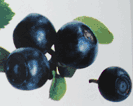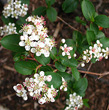Sorin-Liviu Averchi
Aronia
Chokeberry (aronia) nutrition facts
Chokeberry is one of its own kinds of berries packed with essential phytonutrients, vitamins, and antioxidants. These tiny, wild, sub-arctic berries have recently grabbed the attention of fitness lovers and food scientists alike for their promising nutritive values.
Botanically, black chokeberries belong to the Rosaceae family, of the genus: Aronia. Scientific name: Aronia melanocarpa. Red chokeberries belong to the same species and have the botanical name: Aronia arbutifolia.
 |
 |
| Black chokeberries. (Aronia melanocarpa). | Aronia bloom. (Photo: Linda.N) |
At least two species of chokeberries cultivated, black and red. Black chokeberry is a small, deciduous shrub native to North-American cold regions. It grows to about 5 to 8 feet tall and bears many small, about 1 cm in diameter, fruits with relatively thick, pigmented skin in pendulous clusters. Red berries are sweeter than black varieties, while the latter are slightly bitter in taste. However, black and blue color berries are rather rich sources anthocyanin class of pigment antioxidants.
Health benefits of chokeberry
-
Chokeberries are low in calories and fats. 100 g of fresh berries carry around 50 calories. Nonetheless, they are one of the richest sources of flavonoid anthocyanin antioxidants among the bush berries. Also, they contain handsome levels of minerals and vitamins. Besides, their peel is also a good source of dietary fiber.
-
The oxygen radical absorbency capacity or ORAC (measurement of the antioxidant strength of food items) demonstrates chokeberry with one of the highest values recorded among berries-16,062 micromoles of Trolox Equivalents (TE) per 100 g.
-
Black chokeberries consist of significantly high amounts of phenolic flavonoid phytochemicals called anthocyanins. Total anthocyanin content is 1480 mg per 100 g of fresh berries, and proanthocyanidin concentration is 664 mg per 100 g (Wu et al. 2004, 2006). Scientific studies have shown that consumption of berries on a regular basis offers potential health benefits against cancer, aging and neurological diseases, inflammation, diabetes, and bacterial infections. (- By Dr. Paul Gross, 2007-07-09).
-
Laboratory analyses of anthocyanins in chokeberries have identified the following individual chemicals: cyanidin-3-galactoside, quercetin, peonidin, delphinidin, petunidin, epicatechin, caffeic acid, pelargonidin, and malvidin. These flavonoid poly-phenolic antioxidants have proven health benefits through scavenging dangerous oxygen-free radicals from the body.
-
Cancer research on anthocyanins in black chokeberry preparations was first used to inhibit chemically induced cancer in the rat esophagus and was found to reduce the disease severity by 30-60% and that of the colon cancer by up to 80%. Their tumor suppression activity works at a different level of tumor activity; at initiation and promotion/progression stages of tumor development. They can be a practical research tool and hold a promising therapeutic resource since they contain the highest amount of anthocyanins among native North American berries [J. Agric. Food Chem. 50 (12): 3495–500].
-
They are also rich in flavonoid antioxidants such as carotenes, lutein, and zeaxanthins. Zea-xanthin has photo-filtering effects on UV rays and thus protects eyes from the age-related macular disease in the elderly (ARMD).
-
Further, they are also good sources of many antioxidant vitamins like vitamin-C,vitamin-A, vitamin-E, beta-carotene and folate and minerals like potassium, iron, and manganese. 100 g of fresh berries provide about 35% of daily recommended levels of vitamin-C.
- Antidiabetic Effects of Aronia melanocarpa and Its Other Therapeutic Properties
Ines Banjari, Andreja Misir, [...], and Viduranga Y. Waisundara
-
Effect of Bioactive Compound of Aronia melanocarpa on Cardiovascular System in Experimental Hypertension
Martina Cebova, Jana Klimentova, [...], and Olga Pechanova
-
Fruits of Black Chokeberry Aronia melanocarpa in the Prevention of Chronic Diseases
-
Tunde Jurikova, Jiri Mlcek, [...], and Jana Orsavova
- https://www.cerdaculcuaronia.com/448324021







